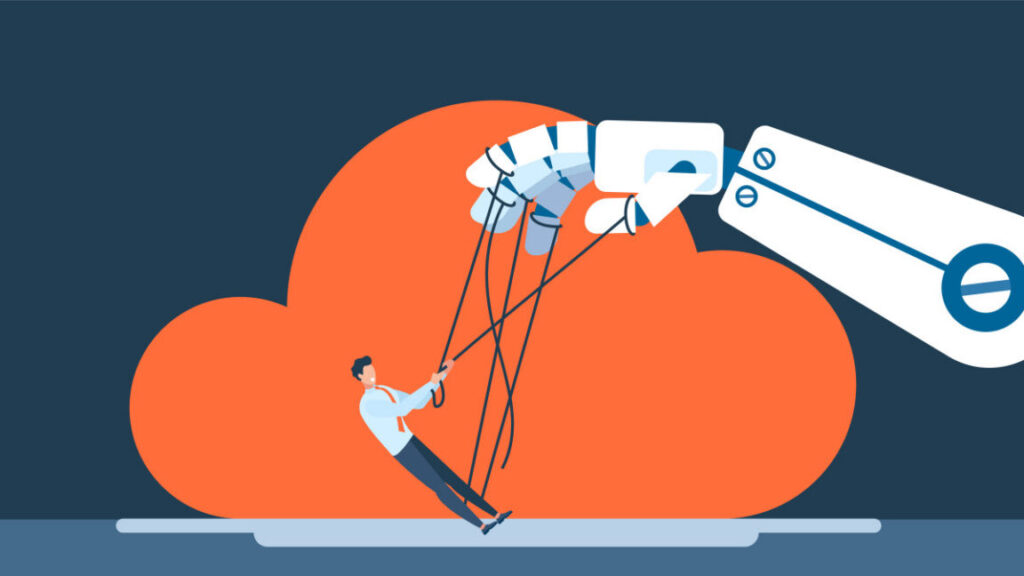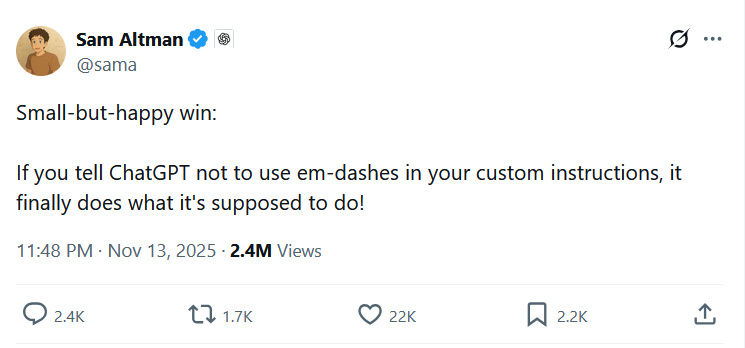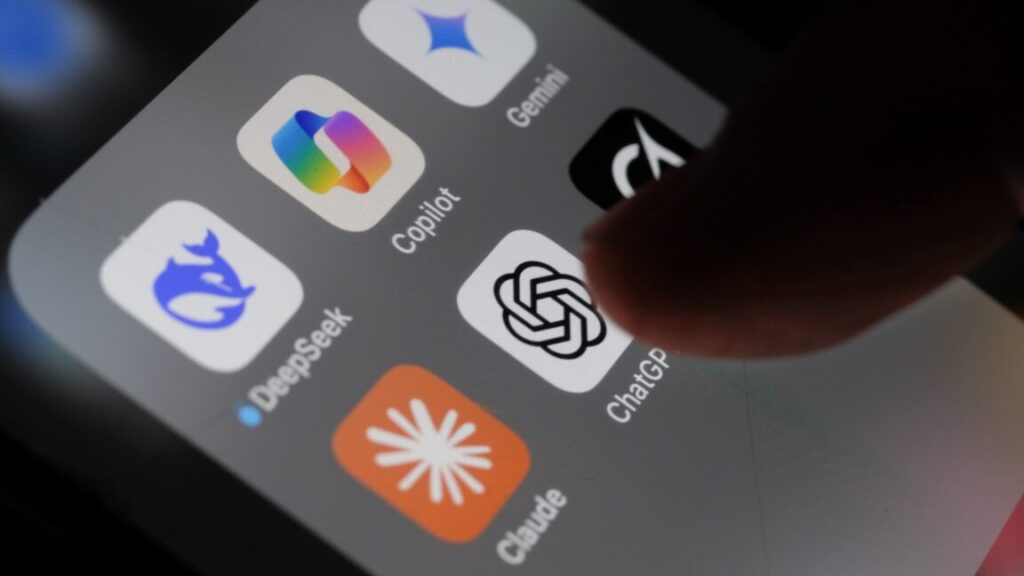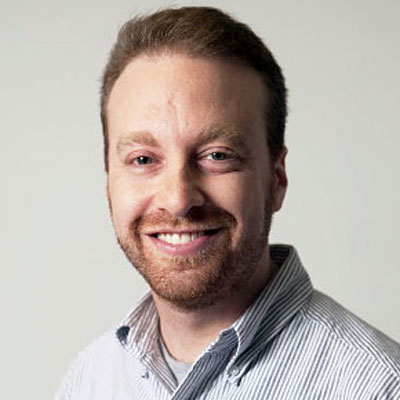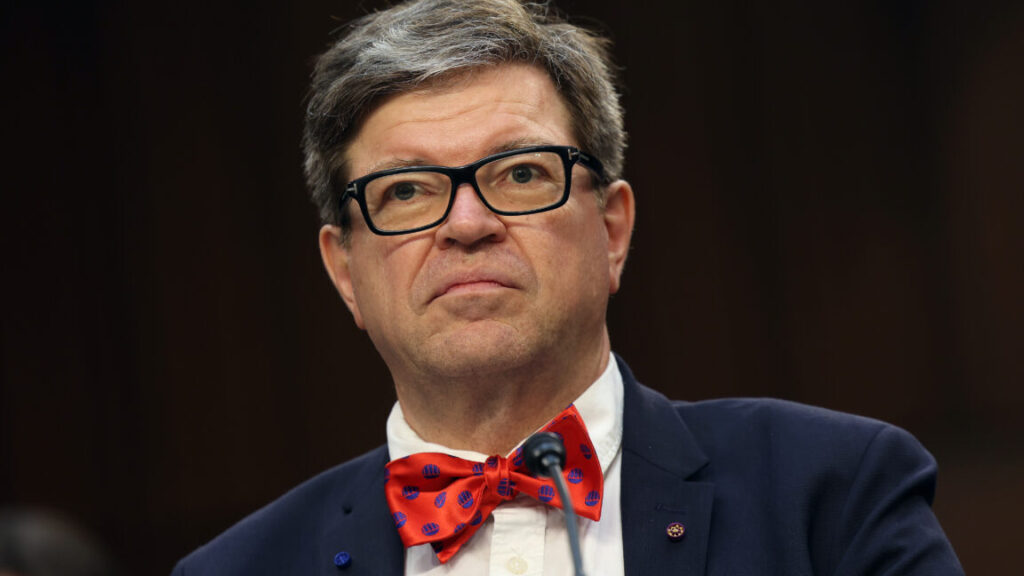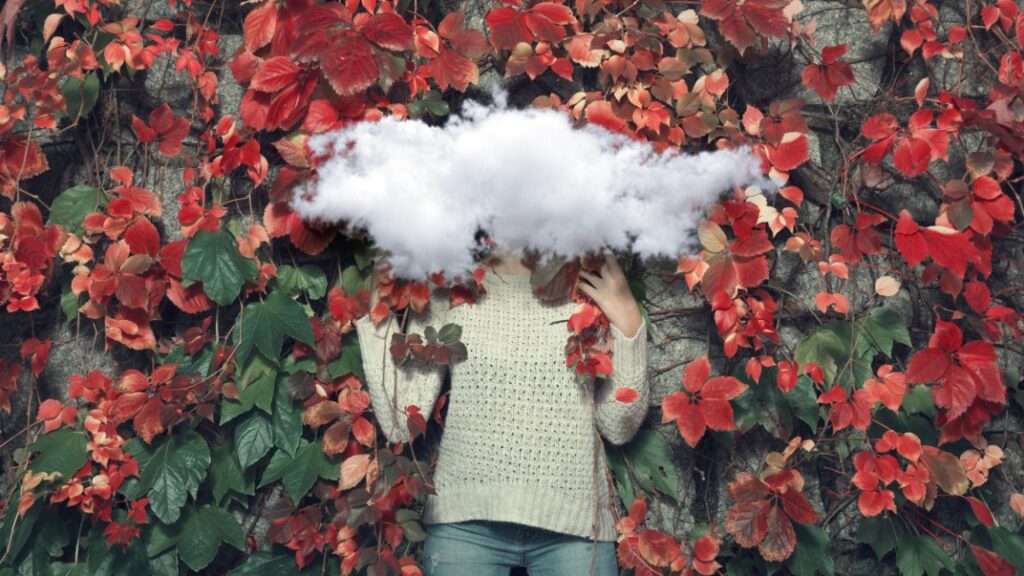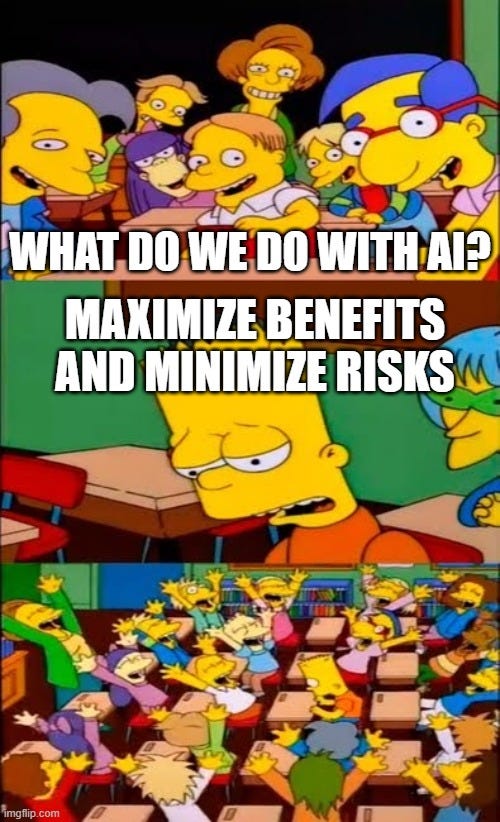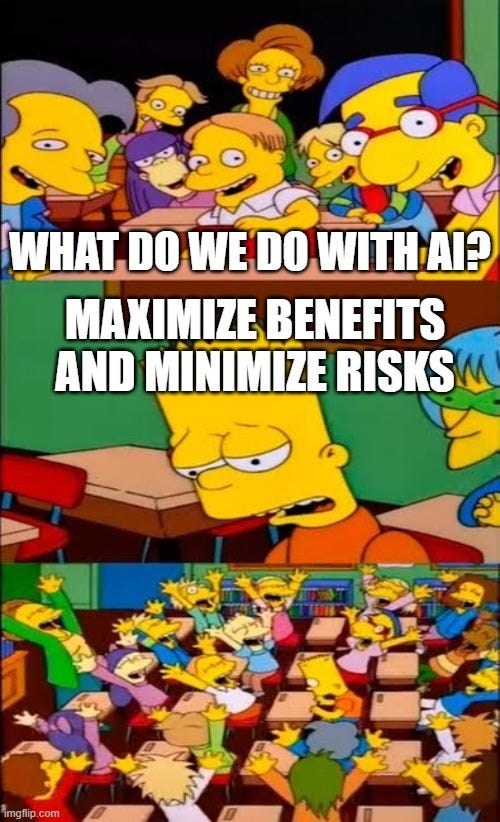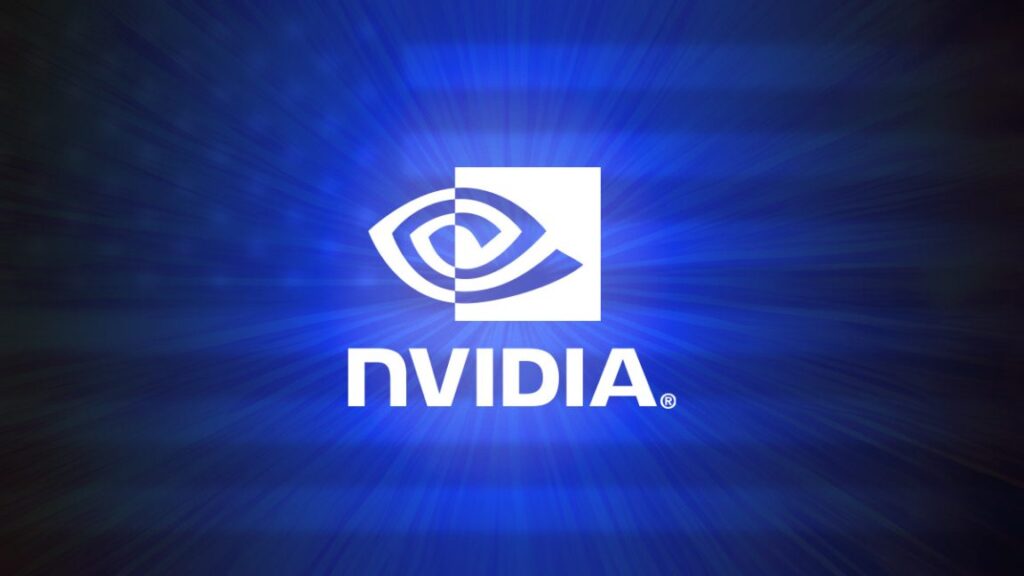OpenAI is now set to become a Public Benefit Corporation, with its investors entitled to uncapped profit shares. Its nonprofit foundation will retain some measure of control and a 26% financial stake, in sharp contrast to its previous stronger control and much, much larger effective financial stake. The value transfer is in the hundreds of billions, thus potentially the largest theft in human history.
I say potentially largest because I realized one could argue that the events surrounding the dissolution of the USSR involved a larger theft. Unless you really want to stretch the definition of what counts this seems to be in the top two.
I am in no way surprised by OpenAI moving forward on this, but I am deeply disgusted and disappointed they are being allowed (for now) to do so, including this statement of no action by Delaware and this Memorandum of Understanding with California.
Many media and public sources are calling this a win for the nonprofit, such as this from the San Francisco Chronicle. This is mostly them being fooled. They’re anchoring on OpenAI’s previous plan to far more fully sideline the nonprofit. This is indeed a big win for the nonprofit compared to OpenAI’s previous plan. But the previous plan would have been a complete disaster, an all but total expropriation.
It’s as if a mugger demanded all your money, you talked them down to giving up half your money, and you called that exchange a ‘change that recapitalized you.’
As in, they claim OpenAI has ‘completed its recapitalization’ and the nonprofit will now only hold equity OpenAI claims is valued at approximately $130 billion (as in 26% of the company, which is actually to be fair worth substantially more than that if they get away with this), as opposed to its previous status of holding the bulk of the profit interests in a company valued at (when you include the nonprofit interests) well over $500 billion, along with a presumed gutting of much of the nonprofit’s highly valuable control rights.
They claim this additional clause, presumably the foundation is getting warrants with but they don’t offer the details here:
If OpenAI Group’s share price increases greater than tenfold after 15 years, the OpenAI Foundation will receive significant additional equity. With its equity stake and the warrant, the Foundation is positioned to be the single largest long-term beneficiary of OpenAI’s success.
We don’t know that ‘significant’ additional equity means, there’s some sort of unrevealed formula going on, but given the nonprofit got expropriated last time I have no expectation that these warrants would get honored. We will be lucky if the nonprofit meaningfully retains the remainder of its equity.
Sam Altman’s statement on this is here, also announcing his livestream Q&A that took place on Tuesday afternoon.
There can be reasonable disagreements about exactly how much. It’s a ton.
There used to be a profit cap, where in Greg Brockman’s own words, ‘If we succeed, we believe we’ll create orders of magnitude more value than any existing company — in which case all but a fraction is returned to the world.’
Well, so much for that.
I looked at this question in The Mask Comes Off: At What Price a year ago.
If we take seriously that OpenAI is looking to go public at a $1 trillion valuation, then consider that Matt Levine estimated the old profit cap only going up to about $272 billion, and that OpenAI still is a bet on extreme upside.
Garrison Lovely: UVA economist Anton Korinek has used standard economic models to estimate that AGI could be worth anywhere from $1.25 to $71 quadrillion globally. If you take Korinek’s assumptions about OpenAI’s share, that would put the company’s value at $30.9 trillion. In this scenario, Microsoft would walk away with less than one percent of the total, with the overwhelming majority flowing to the nonprofit.
It’s tempting to dismiss these numbers as fantasy. But it’s a fantasy constructed in large part by OpenAI, when it wrote lines like, “it may be difficult to know what role money will play in a post-AGI world,” or when Altman said that if OpenAI succeeded at building AGI, it might “capture the light cone of all future value in the universe.” That, he said, “is for sure not okay for one group of investors to have.”
I guess Altman is okay with that now?
Obviously you can’t base your evaluations on a projection that puts the company at a value of $30.9 trillion, and that calculation is deeply silly, for many overloaded and obvious reasons, including decreasing marginal returns to profits.
It is still true that most of the money OpenAI makes in possible futures, it makes as part of profits in excess of $1 trillion.
The Midas Project: Thanks to the now-gutted profit caps, OpenAI’s nonprofit was already entitled to the vast majority of the company’s cash flows. According to OpenAI, if they succeeded, “orders of magnitude” more money would go to the nonprofit than to investors. President Greg Brockman said “all but a fraction” of the money they earn would be returned to the world thanks to the profit caps.
Reducing that to 26% equity—even with a warrant (of unspecified value) that only activates if valuation increases tenfold over 15 years—represents humanity voluntarily surrendering tens or hundreds of billions of dollars it was already entitled to. Private investors are now entitled to dramatically more, and humanity dramatically less.
OpenAI is not suddenly one of the best-resourced nonprofits ever. From the public’s perspective, OpenAI may be one of the worst financially performing nonprofits in history, having voluntarily transferred more of the public’s entitled value to private interests than perhaps any charitable organization ever.
I think Levine’s estimate was low at the time, and you also have to account for equity raised since then or that will be sold in the IPO, but it seems obvious that the majority of future profit interests were, prior to the conversion, still in the hands of the non-profit.
Even if we thought the new control rights were as strong as the old, we would still be looking at a theft in excess of $250 billion, and a plausible case can be made for over $500 billion. I leave the full calculation to others.
The vote in the board was unanimous.
I wonder exactly how and by who they will be sued over it, and what will become of that. Elon Musk, at a minimum, is trying.
They say behind every great fortune is a great crime.
Altman points out that the nonprofit could become the best-resourced non-profit in the world if OpenAI does well. This is true. There is quite a lot they were unable to steal. But it is beside the point, in that it does not make taking the other half, including changing the corporate structure without permission, not theft.
The Midas Project: From the public’s perspective, OpenAI may be one of the worst financially performing nonprofits in history, having voluntarily transferred more of the public’s entitled value to private interests than perhaps any charitable organization ever.
There’s no perhaps on that last clause. On this level, whether or not you agree with the term ‘theft,’ it isn’t even close, this is the largest transfer. Of course, if you take the whole of OpenAI’s nonprofit from inception, performance looks better.
Aidan McLaughlin (OpenAI): ah yes openai now has the same greedy corporate structure as (checks notes) Patagonia, Anthropic, Coursera, and http://Change.org.
Chase Brower: well i think the concern was with the non profit getting a low share.
Aidan McLaughlin: our nonprofit is currently valued slightly less than all of anthropic.
Tyler Johnson: And according to OpenAI itself, it should be valued at approximately three Anthropics! (Fwiw I think the issues with the restructuring extend pretty far beyond valuations, but this is one of them!)
Yes, it is true that the nonprofit, after the theft and excluding control rights, will have an on-paper valuation only slightly lower than the on-paper value of all of Anthropic.
The $500 billion valuation excludes the non-profit’s previous profit share, so even if you think the nonprofit was treated fairly and lost no control rights you would then have it be worth $175 billion rather than $130 billion, so yes slightly less than Anthropic, and if you acknowledge that the nonprofit got stolen from it’s even more.
If OpenAI can successfully go public at a $1 trillion valuation, then depending on how much of that are new shares they will be selling the nonprofit could be worth up to $260 billion.
What about some of the comparable governance structures here? Coursera does seem to be a rather straightforward B-corp. The others don’t?
Patagonia has the closely held Patagonia Purpose Trust, which holds 2% of shares and 100% of voting control, and The Holdfast Collective, which is a 501c(4) nonprofit with 98% of the shares and profit interests. The Chouinard family has full control over the company, and 100% of profits go to charitable causes.
Does that sound like OpenAI’s new corporate structure to you?
Change.org’s nonprofit owns 100% of its PBC.
Does that sound like OpenAI’s new corporate structure to you?
Anthropic is a PBC, but also has the Long Term Benefit Trust. One can argue how meaningfully different this is from OpenAI’s new corporate structure, if you disregard who is involved in all of this.
What the new structure definitely is distinct from is the original intention:
Tomas Bjartur: If not in the know, OpenAI once promised any profits over a threshold would be gifted to you, citizen of the world, for your happy, ultra-wealthy retirement – one needed as they plan to obsolete you. This is now void.
Would OpenAI have been able to raise further investment without withdrawing its profit caps for investments already made?
When you put it like that it seems like obviously yes?
I can see the argument that to raise funds going forward, future equity investments need to not come with a cap. Okay, fine. That doesn’t mean you hand past investors, including Microsoft, hundreds of billions in value in exchange for nothing.
One can argue this was necessary to overcome other obstacles, that OpenAI had already allowed itself to be put in a stranglehold another way and had no choice. But the fundraising story does not make sense.
The argument that OpenAI had to ‘complete its recapitalization’ or risk being asked for its money back is even worse. Investors who put in money at under $200 billion are going to ask for a refund when the valuation is now at $500 billion? Really? If so, wonderful, I know a great way to cut them that check.
I am deeply disappointed that both the Delaware and California attorneys general found this deal adequate on equity compensation for the nonprofit.
I am however reasonably happy with the provisions on control rights, which seem about as good as one can hope for given the decision to convert to a PBC. I can accept that the previous situation was not sustainable in practice given prior events.
The new provisions include an ongoing supervisory role for the California AG, and extensive safety veto points for the NFP and the SSC committee.
If I was confident that these provisions would be upheld, and especially if I was confident their spirit would be upheld, then this is actually pretty good, and if it is used wisely and endures it is more important than their share of the profits.
AG Bonta: We will be keeping a close eye on OpenAI to ensure ongoing adherence to its charitable mission and the protection of the safety of all Californians.
The nonprofit will indeed retain substantial resources and influence, but no I do not expect the public safety mission to dominate the OpenAI enterprise. Indeed, contra the use of the word ‘ongoing,’ it seems clear that it already had ceased to do so, and this seems obvious to anyone tracking OpenAI’s activities, including many recent activities.
What is the new control structure?
OpenAI did not say, but the Delaware AG tells us more and the California AG has additional detail. NFP means OpenAI’s nonprofit here and throughout.
This is the Delaware AG’s non-technical announcement (for the full list see California’s list below), she has also ‘warned of legal action if OpenAI fails to act in public interest’ although somehow I doubt that’s going to happen once OpenAI inevitably does not act in the public interest:
-
The NFP will retain control and oversight over the newly formed PBC, including the sole power and authority to appoint members of the PBC Board of Directors, as well as the power to remove those Directors.
-
The mission of the PBC will be identical to the NFP’s current mission, which will remain in place after the recapitalization. This will include the PBC using the principles in the “OpenAI Charter,” available at openai.com/charter, to execute the mission.
-
PBC directors will be required to consider only the mission (and may not consider the pecuniary interests of stockholders or any other interest) with respect to safety and security issues related to the OpenAI enterprise and its technology.
-
The NFP’s board-level Safety and Security Committee, which is a critical decision maker on safety and security issues for the OpenAI enterprise, will remain a committee of the NFP and not be moved to the PBC. The committee will have the authority to oversee and review the safety and security processes and practices of OpenAI and its controlled affiliates with respect to model development and deployment. It will have the power and authority to require mitigation measures—up to and including halting the release of models or AI systems—even where the applicable risk thresholds would otherwise permit release.
-
The Chair of the Safety and Security Committee will be a director on the NFP Board and will not be a member of the PBC Board. Initially, this will be the current committee chair, Mr. Zico Kolter. As chair, he will have full observation rights to attend all PBC Board and committee meetings and will receive all information regularly shared with PBC directors and any additional information shared with PBC directors related to safety and security.
-
With the intent of advancing the mission, the NFP will have access to the PBC’s advanced research, intellectual property, products and platforms, including artificial intelligence models, Application Program Interfaces (APIs), and related tools and technologies, as well as ongoing operational and programmatic support, and access to employees of the PBC.
-
Within one year of the recapitalization, the NFP Board will have at least two directors (including the Chair of the Safety and Security Committee) who will not serve on the PBC Board.
-
The Attorney General will be provided with advance notice of significant changes in corporate governance.
What did California get?
California also has its own Memorandum of Understanding. It talks a lot in its declarations about California in particular, how OpenAI creates California jobs and economic activity (and ‘problem solving’?) and is committed to doing more of this and bringing benefits and deepening its commitment to the state in particular.
The whole claim via Tweet by Sam Altman that he did not threaten to leave California is raising questions supposedly answered by his Tweet. At this level you perhaps do not need to make your threats explicit.
The actual list seems pretty good, though? Here’s a full paraphrased list, some of which overlaps with Delaware’s announcement above, but which is more complete.
-
Staying in California and expanding the California footprint.
-
The NFP (not for profit) retains control as long as they continue to hold ‘class N common stock’ which only they can choose to give up. What happens if Altman wants that?
-
The PBC and NFP missions will be identical.
-
The OpenAI charter will be published. Check.
-
The NFP Board owes fiduciary duties to the NFP, Mission and public beneficiaries of the NFP. I notice it doesn’t say ‘exclusively’ here.
-
The board shall carry out the charitable purpose (already presumably required).
-
No cheating clause: While the PBC holds Class N Common Stock (again, what happens if Altman tries to end this?) the NFP must approve in advance in writing any amendments to the PBC’s corporate governance guidelines or the mission, any Deemed Liquidation Event, or any sale of material assets of the PBC, or any additional issue of shares of Class N common stock.
-
The PBC can issue Class B common stock, but they can’t let the Bs vote.
-
PBC board and Safety and Security Committee (SSC) must only consider the mission with respect to safety and security issues. The chair of the SSC must be on the NFP board and not the PBC board, but can attend all PBC board meetings and gets all PBC safety and security related information.
-
In particular, the SSC cannot consider shareholder returns, competitive pressures, financial implications or market timing.
-
It seems impossible this will 100% be followed, but it helps.
-
The SSC is a committee of the NFP and oversees safety and security.
-
The SSC can require mitigations up to and including halting releases, without formal justification.
-
“The NFP will provide advance notice to the Attorney General of any material changes to the SSC’s authority.” This is good but worrisome to see, you know?
-
“OpenAI will continue to undertake measures to mitigate risks to teens and others in connection with the development and deployment of AI and of AGI.”
-
I mean, I would hope they were going to do that anyway.
-
The PBC shall give the NFP all reasonable access to services and resources without compensation as needed for the mission.
-
Within a year at least one NFP director, in addition to the SSC chair, will serve only on the NFP board (so at least two directors must be different).
-
The PBC board must be majority independent directors.
-
The PBC will have various good corporate governance things.
-
The PBC will publish a yearly report on its progress in its mission.
-
The NFP Board’s Mission and Strategy Commission will meet with the California AG semi-annually and individual members will be available as needed.
-
The NFP will provide 21 days notice before consenting to changes of PBC control or mission, or any threat to the Class N share rights, or any relocation outside of California.
-
The California AG can review, and hire experts to help review, anything requiring such notice, and get paid by NFP for doing so.
-
Those on both NFP and PBC boards get annual fiduciary duty training.
-
The board represents that the recapitalization is fair (whoops), and that they’ve disclosed everything relevant (?), so the AG will also not object.
-
This only impacts the parties to the MOU, others retain all rights. Disputes resolved in the courts of San Francisco, these are the whole terms, we all have the authority to do this, effective as of signing, AG is relying on OpenAI’s representations and the AG retains all rights and waive none as per usual.
Also, it’s not even listed in the memo, but the ‘merge and assist’ clause was preserved, meaning OpenAI commits to join forces with any ‘safety-conscious’ rival that has a good chance of reaching OpenAI’s goal of creating AGI within a two-year time frame. I don’t actually expect an OpenAI-Anthropic merger to happen, but it’s a nice extra bit of optionality.
This is better than I expected, and as Ben Shindel points out better than many traders expected. This actually does have real teeth, and it was plausible that without pressure there would have been no teeth at all.
It grants the NFP the sole power to appoint and remove directors, and requiring them not to consider the for-profit mission in safety contexts. The explicit granting of the power to halt deployments and mandate mitigations, without having to cite any particular justification and without respect to profitability, is highly welcome, if structured in a functional fashion.
It is remarkable how little many expected to get. For example, here’s Todor Markov, who didn’t even expect the NFP to be able to replace directors at all. If you can’t do that, you’re basically dead in the water.
I am not a lawyer, but my understanding is that the ‘no cheating around this’ clauses are about as robust as one could reasonably hope for them to be.
It’s still, as Garrison Lovely calls it, ‘on paper’ governance. Sometimes that means governance in practice. Sometimes it doesn’t. As we have learned.
The distinction between the boards still means there is an additional level removed between the PBC and the NFP. In a fast moving situation, this makes a big difference, and the NFP likely would have to depend on its enumerated additional powers being respected. I would very much have liked them to include appointing or firing the CEO directly.
Whether this overall ‘counts as a good deal’ depends on your baseline. It’s definitely a ‘good deal’ versus what our realpolitik expectations projected. One can argue that if the control rights really are sufficiently robust over time, that the decline in dollar value for the nonprofit is not the important thing here.
The counterargument to that is both that those resources could do a lot of good over time, and also that giving up the financial rights has a way of leading to further giving up control rights, even if the current provisions are good.
Similarly to many issues of AI alignment, if an entity has ‘unnatural’ control, or ‘unnatural’ profit interests, then there are strong forces that continuously try to take that control away. As we have already seen.
Unless Altman genuinely wants to be controlled, the nonprofit will always be under attack, where at every move we fight to hold its ground. On a long enough time frame, that becomes a losing battle.
Right now, the OpenAI NFP board is essentially captured by Altman, and also identical to the PBC board. They will become somewhat different, but no matter what it only matters if the PBC board actually tries to fulfill its fiduciary duties rather than being a rubber stamp.
One could argue that all of this matters little, since the boards will both be under Altman’s control and likely overlap quite a lot, and they were already ignoring their duties to the nonprofit.
Robert Weissman, co-president of the nonprofit Public Citizen, said this arrangement does not guarantee the nonprofit independence, likening it to a corporate foundation that will serve the interests of the for profit.
Even as the nonprofit’s board may technically remain in control, Weissman said that control “is illusory because there is no evidence of the nonprofit ever imposing its values on the for profit.”
So yes, there is that.
They claim to now be a public benefit corporation, OpenAI Group PBC.
OpenAI: The for-profit is now a public benefit corporation, called OpenAI Group PBC, which—unlike a conventional corporation—is required to advance its stated mission and consider the broader interests of all stakeholders, ensuring the company’s mission and commercial success advance together.
This is a mischaracterization of how PBCs work. It’s more like the flip side of this. A conventional corporation is supposed to maximize profits and can be sued if it goes too far in not doing that. Unlike a conventional corporation, a PBC is allowed to consider those broader interests to a greater extent, but it is not in practice ‘required’ to do anything other than maximize profits.
One particular control right is the special duty to the mission, especially via the safety and security committee. How much will they attempt to downgrade the scope of that?
The Midas Project: However, the effectiveness of this safeguard will depend entirely on how broadly “safety and security issues” are defined in practice. It would not be surprising to see OpenAI attempt to classify most business decisions—pricing, partnerships, deployment timelines, compute allocation—as falling outside this category.
This would allow shareholder interests to determine the majority of corporate strategy while minimizing the mission-only standard to apply to an artificially narrow set of decisions they deem easy or costless.
They have an announcement about that too.
OpenAI: First, Microsoft supports the OpenAI board moving forward with formation of a public benefit corporation (PBC) and recapitalization.
Following the recapitalization, Microsoft holds an investment in OpenAI Group PBC valued at approximately $135 billion, representing roughly 27 percent on an as-converted diluted basis, inclusive of all owners—employees, investors, and the OpenAI Foundation. Excluding the impact of OpenAI’s recent funding rounds, Microsoft held a 32.5 percent stake on an as-converted basis in the OpenAI for-profit.
Anyone else notice something funky here? OpenAI’s nonprofit has had its previous rights expropriated, and been given 26% of OpenAI’s shares in return. If Microsoft had 32.5% of the company excluding the nonprofit’s rights before that happened, then that should give them 24% of the new OpenAI. Instead they have 27%.
I don’t know anything nonpublic on this, but it sure looks a lot like Microsoft insisted they have a bigger share than the nonprofit (27% vs. 26%) and this was used to help justify this expropriation and a transfer of additional shares to Microsoft.
In exchange, Microsoft gave up various choke points it held over OpenAI, including potential objections to the conversion, and clarified points of dispute.
Microsoft got some upgrades in here as well.
-
Once AGI is declared by OpenAI, that declaration will now be verified by an independent expert panel.
-
Microsoft’s IP rights for both models and products are extended through 2032 and now includes models post-AGI, with appropriate safety guardrails.
-
Microsoft’s IP rights to research, defined as the confidential methods used in the development of models and systems, will remain until either the expert panel verifies AGI or through 2030, whichever is first. Research IP includes, for example, models intended for internal deployment or research only.
-
Beyond that, research IP does not include model architecture, model weights, inference code, finetuning code, and any IP related to data center hardware and software; and Microsoft retains these non-Research IP rights.
-
Microsoft’s IP rights now exclude OpenAI’s consumer hardware.
-
OpenAI can now jointly develop some products with third parties. API products developed with third parties will be exclusive to Azure. Non-API products may be served on any cloud provider.
-
Microsoft can now independently pursue AGI alone or in partnership with third parties. If Microsoft uses OpenAI’s IP to develop AGI, prior to AGI being declared, the models will be subject to compute thresholds; those thresholds are significantly larger than the size of systems used to train leading models today.
-
The revenue share agreement remains until the expert panel verifies AGI, though payments will be made over a longer period of time.
-
OpenAI has contracted to purchase an incremental $250B of Azure services, and Microsoft will no longer have a right of first refusal to be OpenAI’s compute provider.
-
OpenAI can now provide API access to US government national security customers, regardless of the cloud provider.
-
OpenAI is now able to release open weight models that meet requisite capability criteria.
That’s kind of a wild set of things to happen here.
In some key ways Microsoft got a better deal than it previously had. In particular, AGI used to be something OpenAI seemed like it could simply declare (you know, like war or the defense production act) and now it needs to be verified by an ‘expert panel’ which implies there is additional language I’d very much like to see.
In other ways OpenAI comes out ahead. An incremental $250B of Azure services sounds like a lot but I’m guessing both sides are happy with that number. Getting rid of the right of first refusal is big, as is having their non-API products free and clear. Getting hardware products fully clear of Microsoft is a big deal for the Ives project.
My overall take here is this was one of those broad negotiations where everything trades off, nothing is done until everything is done, and there was a very wide ZOPA (zone of possible agreement) since OpenAI really needed to make a deal.
In theory govern the OpenAI PBC. I have my doubts about that.
What they do have is a nominal pile of cash. What are they going to do with it to supposedly ensure that AGI goes well for humanity?
The default, as Garrison Lovely predicted a while back, is that the nonprofit will essentially buy OpenAI services for nonprofits and others, recapture much of the value and serve as a form of indulgences, marketing and way to satisfy critics, which may or may not do some good along the way.
The initial $50 million spend looked a lot like exactly this.
Their new ‘initial focus’ for $25 billion will be in these two areas:
-
Health and curing diseases. The OpenAI Foundation will fund work to accelerate health breakthroughs so everyone can benefit from faster diagnostics, better treatments, and cures. This will start with activities like the creation of open-sourced and responsibly built frontier health datasets, and funding for scientists.
-
Technical solutions to AI resilience. Just as the internet required a comprehensive cybersecurity ecosystem—protecting power grids, hospitals, banks, governments, companies, and individuals—we now need a parallel resilience layer for AI. The OpenAI Foundation will devote resources to support practical technical solutions for AI resilience, which is about maximizing AI’s benefits and minimizing its risks.
Herbie Bradley: i love maximizing AI’s benefits and minimizing its risks
They literally did the meme.
The first seems like a generally worthy cause that is highly off mission. There’s nothing wrong with health and curing diseases, but pushing this now does not advance the fundamental mission of OpenAI. They are going to start with, essentially, doing AI capabilities research and diffusion in health, and funding scientists to do AI-enabled research. A lot of this will likely fall right back into OpenAI and be good PR.
Again, that’s a net positive thing to do, happy to see it done, but that’s not the mission.
Technical solutions to AI resilience could potentially at least be useful AI safety work to some extent. With a presumed ~$12 billion this is a vast overconcentration of safety efforts into things that are worth doing but ultimately don’t seem likely to be determining factors. Note how Altman described it in his tl;dr from the Q&A:
Sam Altman: The nonprofit is initially committing $25 billion to health and curing disease, and AI resilience (all of the things that could help society have a successful transition to a post-AGI world, including technical safety but also things like economic impact, cyber security, and much more). The nonprofit now has the ability to actually deploy capital relatively quickly, unlike before.
This is now infinitely broad. It could be addressing ‘economic impact’ and be basically a normal (ineffective) charity, or one that intervenes mostly by giving OpenAI services to normal nonprofits. It could be mostly spent on valuable technical safety, and be on the most important charitable initiatives in the world. It could be anything in between, in any distribution. We don’t know.
My default assumption is that this is primarily going to be about mundane safety or even fall short of that, and make the near term world better, perhaps importantly better, but do little to guard against the dangers or downsides of AGI or superintelligence, and again largely be a de facto customer of OpenAI.
There’s nothing wrong with mundane risk mitigation or defense in depth, and nothing wrong with helping people who need a hand, but if your plan is ‘oh we will make things resilient and it will work out’ then you have no plan.
That doesn’t mean this will be low impact, or that what OpenAI left the nonprofit with is chump change.
I also don’t want to knock the size of this pool. The previous nonprofit initiative was $50 million, which can do a lot of good if spent well (in that case, I don’t think it was) but in this context $50 million chump change.
Whereas $25 billion? Okay, yeah, we are talking real money. That can move needles, if the money actually gets spent in short order. If it’s $25 billion as a de facto endowment spent down over a long time, then this matters and counts for a lot less.
The warrants are quite far out of the money and the NFP should have gotten far more stock than it did, but 26% (worth $130 billion or more) remains a lot of equity. You can do quite a lot of good in a variety of places with that money. The board of directors of the nonprofit is highly qualified if they want to execute on that. It also is highly qualified to effectively shuttle much of that money right back to OpenAI’s for profit, if that’s what they mainly want to do.
It won’t help much with the whole ‘not dying’ or ‘AGI goes well for humanity’ missions, but other things matter too.
Not entirely. As Garrison Lovely notes, all these sign-offs are provisional, and there are other lawsuits and the potential for other lawsuits. In a world where Elon Musk’s payouts can get crawled back, I wouldn’t be too confident that this conversation sticks. It’s not like the Delaware AG drives most objections to corporate actions.
The last major obstacle is the Elon Musk lawsuit, where standing is at issue but the judge has made clear that the suit otherwise has merit. There might be other lawsuits on the horizon. But yeah, probably this is happening.
So this is the world we live in. We need to make the most of it.

